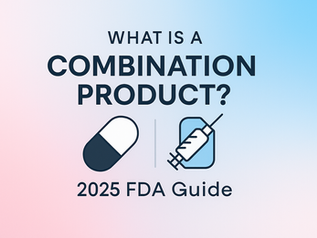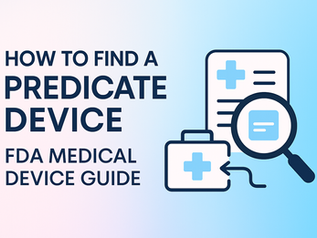top of page


How Long Does It Take to Bring a Medical Device to Market?
For most Class II medical devices cleared through the 510(k) pathway , companies should plan for multiple years from concept to commercial launch , not months. While every product is different, 18–36 months is a common planning range once design complexity, testing, and regulatory realities are accounted for. FDA does not publish end-to-end “time-to-market” timelines. Delays usually come from underestimating development effort, testing lead times, and regulatory iteration ,
13 minutes ago13 min read


FDA Performance Testing Requirements: Complete Bench, Software, and Biocompatibility Guide
FDA expects performance testing that demonstrates your device functions as intended and does not raise different questions of safety or effectiveness compared to your predicate. The scope of testing depends on device type, risk, and technological differences, but most 510(k)s include bench or performance testing , software validation where applicable , and biocompatibility assessment for patient-contacting components . This guide shows you exactly which tests FDA requires for
3 days ago14 min read


What Happens If FDA Disagrees With Your Predicate Device? Complete Response Guide
If FDA disagrees with your predicate choice, you'll get an Additional Information (AI) request or a Not Substantially Equivalent (NSE) determination. AI requests often add months and require either: (1) switching to a different predicate, (2) providing stronger substantial equivalence rationale, or (3) withdrawing and refiling. Not Substantially Equivalent (NSE) determination usually means you must submit new 510(k) with different predicate or pursue De Novo. This guide walks
4 days ago9 min read


Human Factors Engineering for Medical Devices: Complete FDA Usability Guide
Human Factors Engineering (HFE), also called usability engineering, is how FDA expects you to show that intended users can operate your device safely and effectively in the intended use environment, especially when use error could cause harm. For many higher-risk device types, FDA often expects human factors data in 510(k)s and PMAs, and it is common to see it in De Novo programs when the user interface drives risk. If you change a user interface in a way that can affect comp
5 days ago9 min read


How Much Does a 510(k) Cost? Complete Budget Breakdown
A 510(k) submission costs between $50,000 and $250,000+ depending on device complexity, testing requirements, and whether you use consultants. Core costs include FDA user fees ($6,517-$26,067), testing/validation ($20,000-$150,000+), consultant fees ($15,000-$50,000), and establishment registration ($11,423). Most startups underestimate by 40-60%, with hidden costs from AI requests, design changes, and regulatory delays adding $30,000-$100,000+ to initial budgets. You've bui
Dec 911 min read


10 Reasons FDA Submissions Fail — Even When You Think You're Ready
FDA 510(k) submissions most often stumble on preventable issues: incomplete or non-compliant admin packets at Refuse to Accept (RTA) review, weak or inconsistent device descriptions and indications for use, poor predicate selection, missing or insufficient testing data, and failure to follow device-specific FDA guidance. Historically, RTA refusal rates have climbed as high as ~60% of new 510(k)s, and even in recent years roughly one-third of submissions hit an RTA hold at lea
Dec 818 min read


How to Build a Medical Device Regulatory Strategy: Complete Guide
A medical device regulatory strategy is your comprehensive plan for achieving FDA clearance or approval. It includes device classification, pathway selection (510(k), De Novo, or PMA), resource planning (team, budget, consultants), timeline mapping, testing strategy, and risk mitigation. Build it during concept phase—before design freeze or testing begins—to avoid expensive mistakes and accelerate market entry. Companies that build regulatory strategy during concept phase mak
Nov 1016 min read


How to Bring a Medical Device to the U.S. Market: Complete 2025 Guide
To bring a medical device to the U.S. market: (1) Classify your device (Class I, II, or III), (2) select your regulatory pathway (510(k), De Novo, or PMA), (3) complete required testing, (4) prepare and submit your FDA application, and (5) maintain post-clearance QMS compliance. Timeline ranges from 3-6 months for 510(k) to 1-3 years for PMA. This guide provides the complete roadmap from concept to U.S. market launch, with decision frameworks at each stage to help you avoid t
Nov 913 min read


FDA Third-Party Review (3P510k): The Overlooked Route to Faster 510(k) Clearance (Complete Guide)
The FDA’s 510(k) Third-Party Review Program (3P510k) is a voluntary alternative pathway allowing accredited organizations to review certain eligible Class I and II medical devices instead of FDA performing the full review.Third-party reviewers forward their technical recommendation to FDA, which aims to issue a final clearance decision within about 30 calendar days of receiving the complete review package. By using the 3P510k route, you avoid paying FDA user fees , thoug
Oct 217 min read


How to Prepare Your First FDA Submission: Step-by-Step Guide 2025
Preparing your first FDA submission involves five critical steps: classify your device accurately, determine the appropriate regulatory pathway (510(k), De Novo, or PMA), gather required technical and clinical documentation, consider engaging FDA through a Pre-Submission meeting, and submit through FDA's electronic systems with proper formatting and user fees. This guide provides practical, step-by-step preparation strategies specifically for startup founders navigating their
Oct 179 min read


How the FDA Reviews AI and Machine Learning Medical Devices: Complete 2025 Guide
FDA reviews AI and machine learning medical devices using a regulatory framework designed for adaptive software that learns over time. The approach includes Predetermined Change Control Plans (PCCPs) that allow pre-approved algorithm modifications without additional submissions, Good Machine Learning Practice guidelines, and lifecycle management requirements addressing transparency and bias concerns. This guide covers FDA's AI/ML regulatory framework, submission requirements,
Oct 67 min read


What Is a Design History File (DHF)? Complete 2025 Guide
A Design History File (DHF) is a mandatory compilation of records documenting how a medical device was designed and developed according to FDA requirements under 21 CFR Part 820.30. The DHF demonstrates that design controls were followed throughout development and serves as primary evidence during FDA audits and regulatory submissions. This guide covers DHF requirements, contents, creation process, and compliance strategies to help you build audit-ready documentation. What Is
Sep 226 min read


What Is FDA Device Registration and Listing? Complete 2025 Guide
FDA device registration and listing is a mandatory annual process where medical device companies register their facilities and list their specific products with FDA. Registration identifies WHO makes devices, while listing identifies WHAT devices are made. Both are required before commercial distribution in the US. This guide covers requirements, deadlines, fees, and step-by-step compliance to help you avoid delays and maintain market access. What Is FDA Device Registration a
Sep 175 min read


FDA Compliance for Medical Devices: Complete Beginner's Guide 2025
FDA compliance for medical devices isn't optional - it's the gateway to the largest medical device market. In the US, “FDA compliance” means: classify the product (Class I/II/III), choose the correct route— 510(k) clearance , De Novo classification , PMA approval , or 510(k)-exempt —run a compliant quality system (QSR until Feb 2, 2026 ; QMSR afterward), apply labeling/UDI rules, register & list establishments/devices, and meet postmarket duties (MDR 803, corrections/re
Aug 219 min read


What are Combination Products? 2025 FDA Medical Device Guide
A combination product combines a medical device with a drug, biologic, or both as a single-entity , co-packaged , or cross-labeled configuration (21 CFR 3.2(e) ). FDA classification depends on the Primary Mode of Action (PMOA) - whichever component provides the most therapeutic benefit determines which FDA center reviews your product and which regulations apply; if unclear, the Office of Combination Products decides, and an RFD yields a binding designation within 60 days
Aug 2010 min read


How to Find a Predicate Device: 2025 FDA Guide
A predicate device is a legally marketed U.S. device with the same intended use and technological characteristics that do not raise different questions of safety and effectiveness compared with your device. Find candidates in FDA’s Product Classification Database (by product code), FDA’s 510(k) database (by device name/manufacturer), and AccessGUDID (public UDI)—which often lists premarket submission numbers you can pivot on. Pick well and you streamline review; pick poorly a
Aug 199 min read


How To Import Medical Devices: FDA Initial Importer Guide 2025
Importing medical devices into the United States requires strict FDA compliance, and the stakes are massive. Medical device importers must ensure premarket compliance (510(k)/PMA), establishment registration and listing, proper CBP filing codes (DEV, LST, PM#), and ongoing MDR obligations. Foreign manufacturers need US agents while initial importers must maintain complaint files in the US. Products that don't meet requirements face detention, refusal, and destruction, often c
Aug 1811 min read


Medical Device Labeling Requirements: Complete FDA 21 CFR 801 Compliance Guide 2025
FDA requires medical device labeling to include manufacturer information, intended use, adequate directions, warnings, UDI (where applicable), and device-specific requirements. Labeling encompasses all written materials including labels, packaging, instructions for use, and promotional materials. Compliance requires both content accuracy and quality system controls under 21 CFR 820.120. This guide covers all FDA labeling requirements, common violations, and compliance strateg
Aug 158 min read


Do I Need FDA Approval, Clearance, or Exemption? 2025 Medical Device Guide
Whether you need FDA approval, FDA clearance, or no regulatory submission at all depends on your device's risk classification and intended use. FDA approval (PMA) is required for high-risk Class III devices. FDA clearance (510(k)) is needed for most Class II devices and some Class I devices. However, most Class I devices and many Class II devices are exempt from premarket submissions but still require FDA registration and listing. This guide provides a complete decision frame
Aug 146 min read


EU MDR vs FDA: 2025 US-EU Medical Device Regulatory Comparison Guide
Medical device companies expanding globally face a critical strategic decision: which regulatory pathway offers the fastest, most...
Aug 1011 min read
bottom of page
